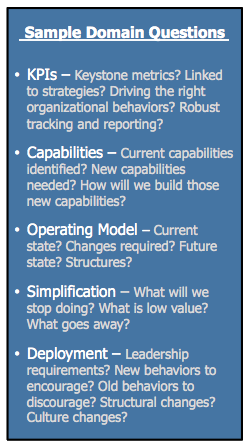 The intent was to fuel earnings growth by using technology to transform a part of the innovation process. The business had spent months and significant resources developing a strategy and detailed business case for the major initiative. They even went so far as to make sure senior leaders signed off on it showing their understanding, voicing their concerns, and then committing their resources to make it successful. Unfortunately, like 60%-80% of all transformation initiatives, their attempt stumbled.
The intent was to fuel earnings growth by using technology to transform a part of the innovation process. The business had spent months and significant resources developing a strategy and detailed business case for the major initiative. They even went so far as to make sure senior leaders signed off on it showing their understanding, voicing their concerns, and then committing their resources to make it successful. Unfortunately, like 60%-80% of all transformation initiatives, their attempt stumbled.
Charged with the responsibility to grow the business, CEOs spend considerable time and resources developing strategy, aligning senior leaders, managing talent, and identifying strategic initiatives to move the business forward. A recent study of business transformation by KMPG as reported by Forbes showed 93% of U.S. based multinationals are involved in some phase of business transformation.
A fraction of the time initiatives like acquisitions or transformation efforts will deliver on their goals. But most of the time, upwards of 80% of the time, those transformation efforts fail to deliver.
And thus the CEO’s dilemma. What are they to do? They have good, sometimes great, talent available. Often they hire some of the largest, most prestigious consulting firms. And they spend a large percentage of their implementation budget training employees. So why are the odds still stacked against them?
CEOs need to increase the probability of success by finishing the job of strategy.
In business, strategy is usually relegated to the executive suite (part of the issue; see more here) and some executives become very good at describing the situation, developing objectives driven by their financial planning commitments, identifying strategies to achieve the objectives, and detailing the targets and plans assigned for accountability.
Some are good at strategy. Many need to get better. But almost all need to finish the job. CEOs need a model for strategy that goes beyond setting targets for the organization to achieve. Too many strategies end up having little to no effect on the business because leaders don’t consider what it takes to execute. And that includes strategies for transformation initiatives.
for the organization to achieve. Too many strategies end up having little to no effect on the business because leaders don’t consider what it takes to execute. And that includes strategies for transformation initiatives.
A robust model for strategy or business case development should focus as much effort on execution as it does on strategy development. And strategy execution includes thinking through and mitigating failure risks in five domains: KPIs, Capabilities, Operating Model, Simplification, and Deployment. These five domains can be arranged in a meta-model like ThinkPoints™. Under each of the domains are a set of tools and methodologies that, when required, will help increase the odds of success and begin to resolve the CEO’s dilemma.
What is your approach to increasing the odds of transformation success? For more information on ThinkPoints™, contact ThinkWay Strategies.